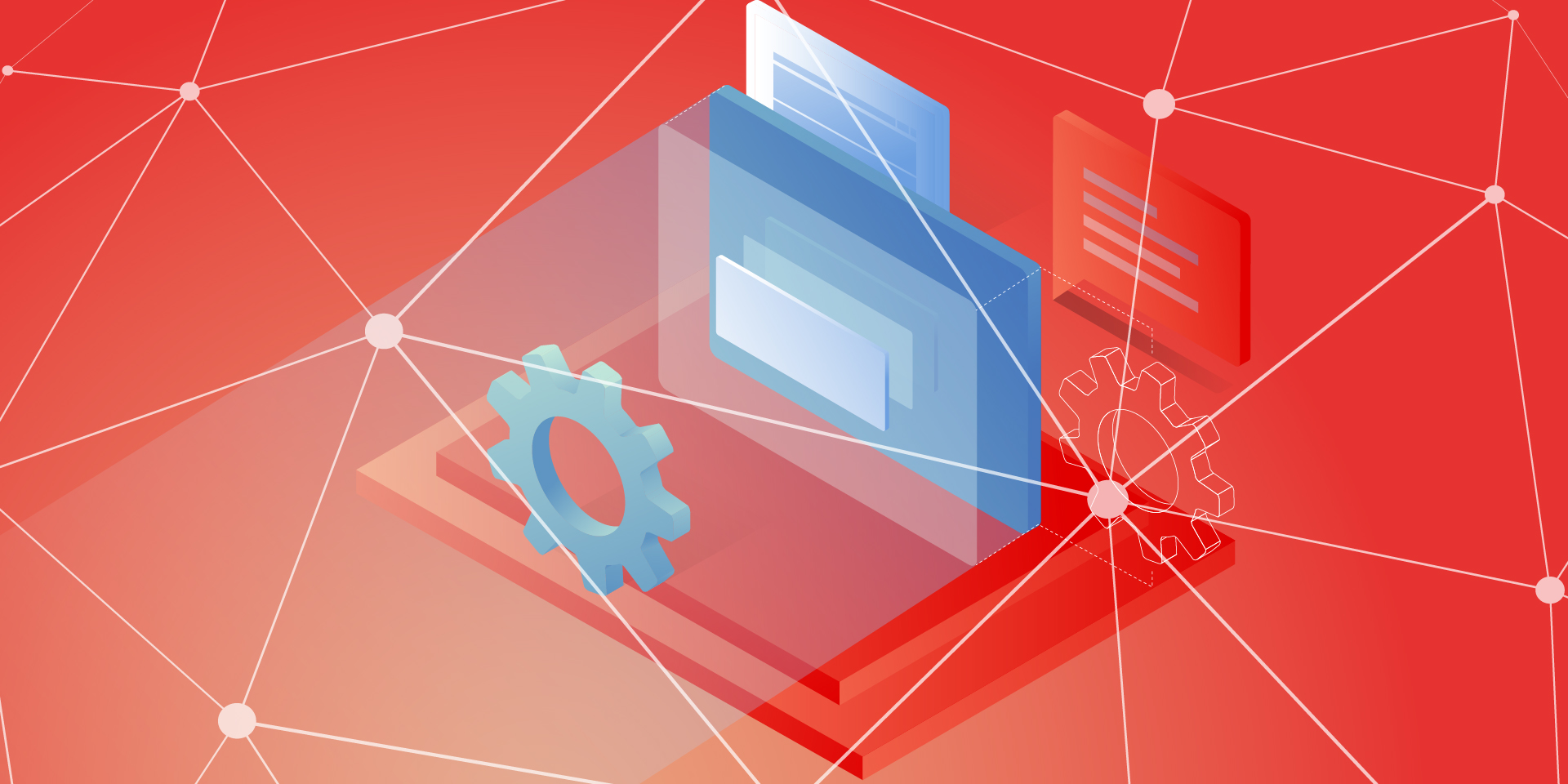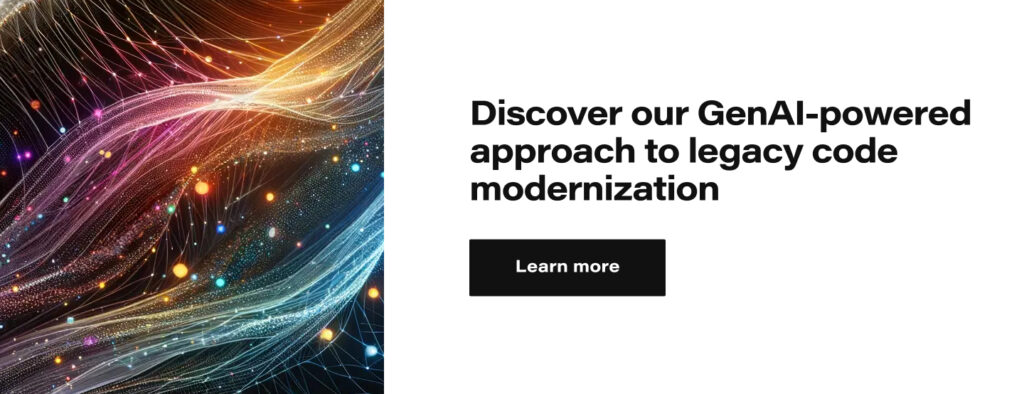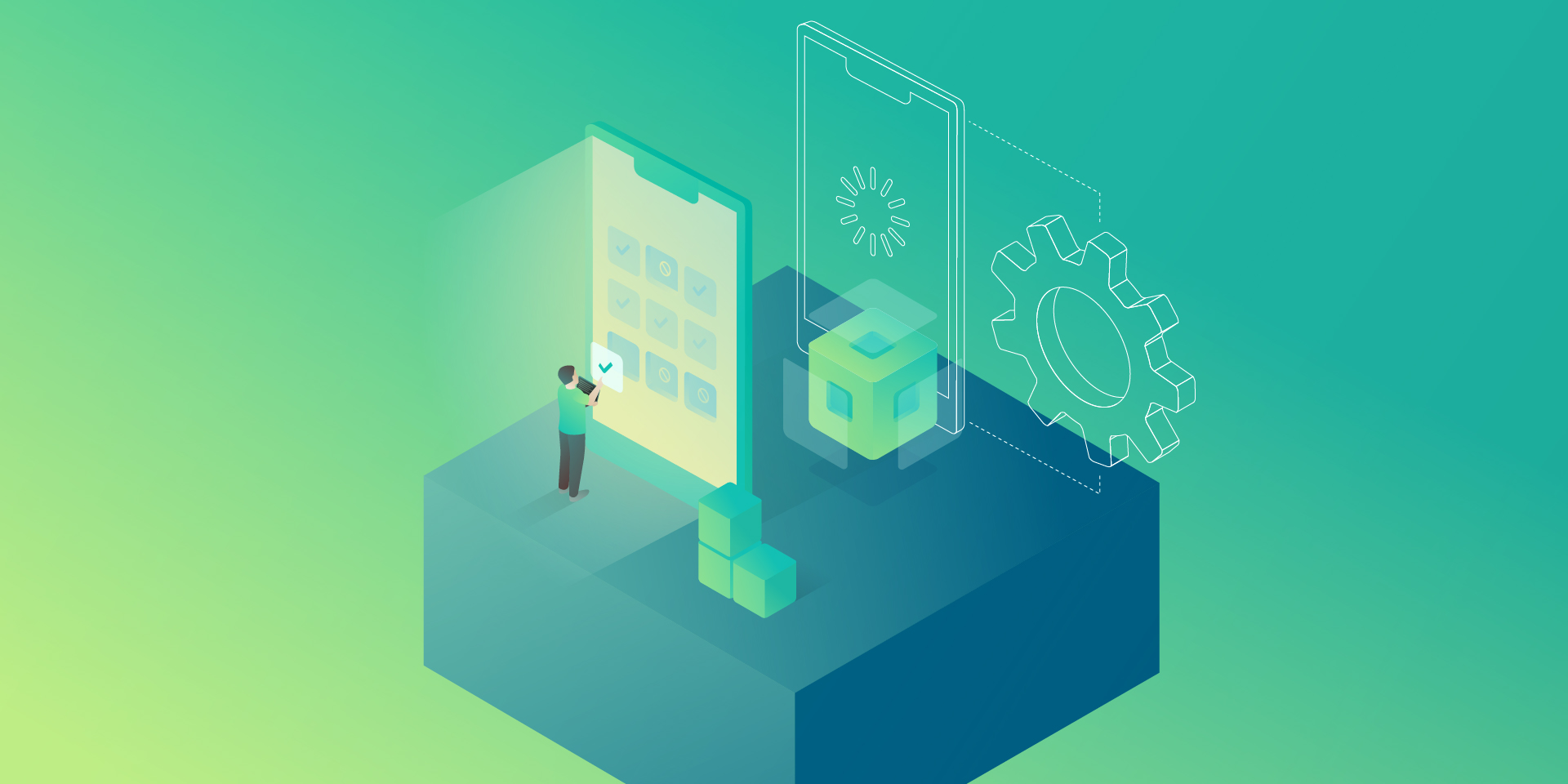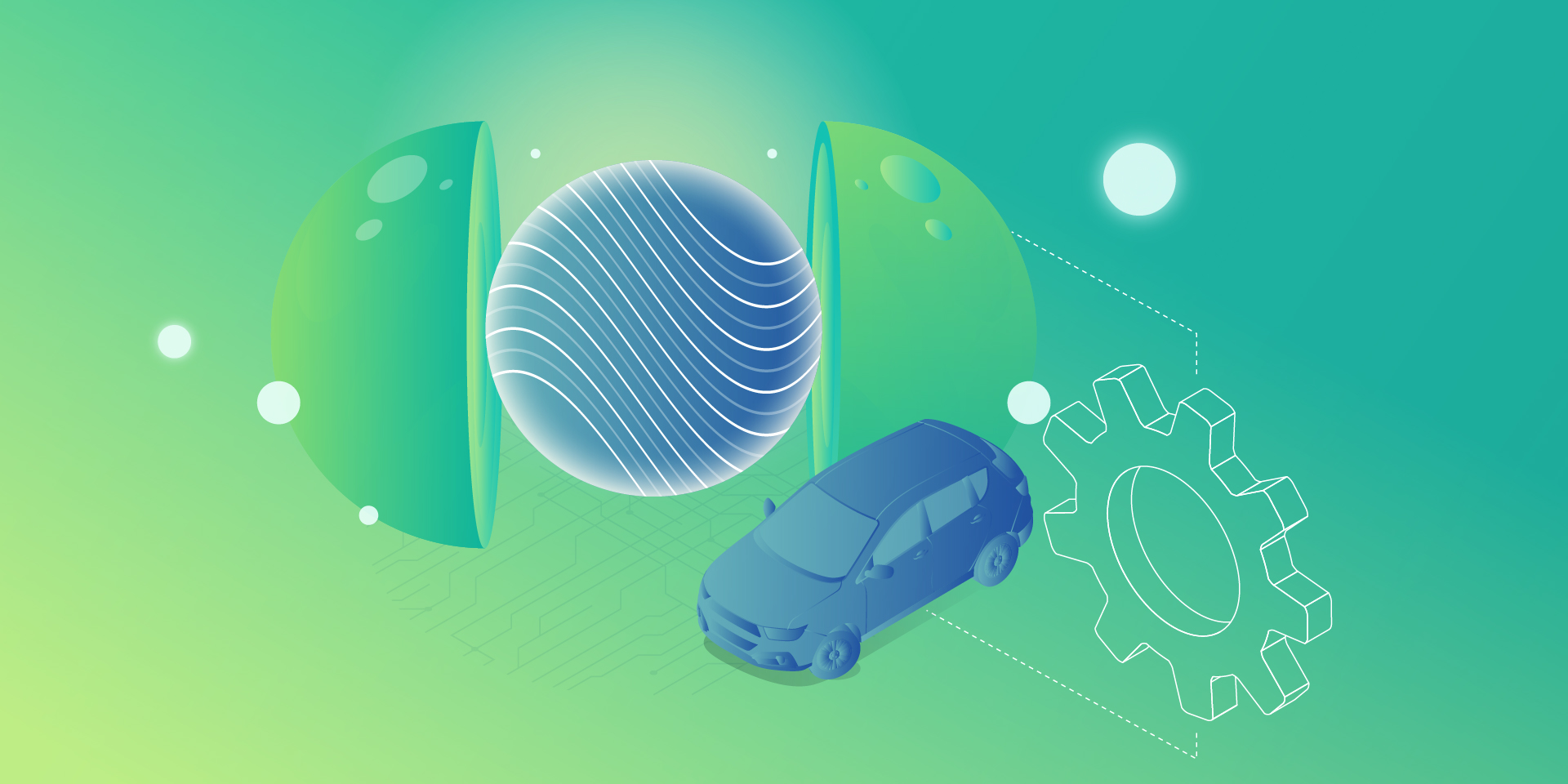Challenges of the Legacy Migration Process and Best Practices to Mitigate Them

Legacy software is the backbone of many organizations, but as technology advances, these systems can become more of a burden than a benefit. Migrating from a legacy system to a modern solution is a daunting task fraught with challenges, from grappling with outdated code and conflicting stakeholder interests to managing dependencies on third-party vendors and ensuring compliance with stringent regulatory standards.
However, with the right strategies and leveraging advanced technologies like Generative AI, these challenges can be effectively mitigated.
Challenge #1: Limited knowledge of the legacy solution
The average lifespan of business software can vary widely depending on several factors, such as the type of software or the industry it serves. Nevertheless, no matter if the software is 5 or 25 years old, it is highly possible its creators and subject matter experts are not accessible anymore (or they barely remember what they built and how it really works), the documentation is incomplete, the code messy and the technology forgotten a long time ago.
Lack of knowledge of the legacy solution not only blocks its further development and maintenance but also negatively affects its migration – it significantly slows down the analysis and replacement process.
Mitigation:
The only way to understand what kind of functionality, processes and dependencies are covered by the legacy software and what really needs to get migrated is in-depth analysis. An extensive discovery phase initiating every migration project should cover:
- interviews with the key users and knowledge keepers,
- observations of the employees and daily operations performed within the system,
- study of all the available documentation and resources,
- source code examination.
The discovery phase, although long (and boring!), demanding, and very costly, is crucial for the migration project’s success. Therefore, it is not recommended to give in to the temptation to take any shortcuts there.
At Grape Up, we do not. We make sure we learn the legacy software in detail, optimizing the analytical efforts at the same time. We support the discovery process by leveraging Generative AI tools. They help us to understand the legacy spaghetti code, forgotten purpose, dependencies, and limitations. GenAI enables us to make use of existing incomplete documentation or to go through technologies that nobody has expertise in anymore. This approach significantly speeds the discovery phase up, making it smoother and more efficient.
Challenge #2: Blurry idea of the target solution & conflicting interests
Unfortunately, understanding the legacy software and having a complete idea of the target replacement are two separate things. A decision to build a new solution, especially in a corporate environment, usually encourages multiple stakeholders (representing different groups of interests) to promote their visions and ideas. Often conflicting, to be precise.
This nonlinear stream of contradicting requirements leads to an uncontrollable growth of the product backlog, which becomes extremely difficult to manage and prioritize. In consequence, efficient decision-making (essential for the product’s success) is barely possible.
Mitigation:
A strong Product Management community with a single product leader – empowered to make decisions and respected by the entire organization – is the key factor here. If combined with a matching delivery model (which may vary depending on a product & project specifics), it sets the goals and frames for the mission and guides its crew.
For huge legacy migration projects with a blurry scope, requiring constant validation and prioritization, an Agile-based, continuous discovery & delivery process is the only possible way to go. With a flexible product roadmap (adjusted on the fly), both creative and development teams work simultaneously, and regular feedback loops are established.
High pressure from the stakeholders always makes the Product Leader’s job difficult. Bold scope decisions become easier when MVP/MDP (Minimum Viable / Desirable Product) approach & MoSCoW (must-have, should-have, could-have, and won’t-have, or will not have right now) prioritization technique are in place.
At Grape Up, we assist our clients with establishing and maintaining efficient product & project governance, supporting the in-house management team with our experienced consultants such as Business Analysts, Scrum Masters, Project Managers, or Proxy Product Owners.
Challenge #3: Strategical decisions impacting the future
Migrating the legacy software gives the organization a unique opportunity to sunset outdated technologies, remove all the infrastructural pain points, reach out for modern solutions, and sketch a completely new architecture.
However, these are very heavy decisions. They must not only address the current needs but also be adaptable to future growth. Wrong choices can result in technical debt, forcing another costly migration – much sooner than planned.
Mitigation:
A careful evaluation of the current and future needs is a good starting point for drafting the first technical roadmap and architecture. Conducting a SWOT analysis (Strengths, Weaknesses, Opportunities, Threats) for potential technologies and infrastructural choices provides a balanced view, helping to identify the most suitable options that align with the organization’s long-term plan. For Grape Up, one of the key aspects of such an analysis is always industry trends.
Another crucial factor that supports this difficult decision-making process is maintaining technical documentation through Architectural Decision Records (ADRs). ADRs capture the rationale behind key decisions, ensuring that all stakeholders understand the choices made regarding technologies, frameworks, or architectures. This documentation serves as a valuable reference for future decisions and discussions, helping to avoid repeating past mistakes or unnecessary changes (e.g. when a new architect joins the team and pushes for his own technical preferences).

Challenge #4: Dependencies and legacy 3rd parties
When migrating from a legacy system, one of the significant challenges is managing dependencies with numerous other applications and services which are integrated with the old solution, and need to remain connected with the new one. Many of these are often provided by third-party vendors that may not be willing or able to quickly respond to our project’s needs and adapt to any changes, posing a significant risk to the migration process. Unfortunately, some of the dependencies are likely to be hidden and spotted not early enough, affecting the project’s budget and timeline.
Mitigation:
To mitigate this risk, it’s essential to establish strong governance over third-party relationships before the project really begins. This includes forming solid partnerships and ensuring that clear contracts are in place, detailing the rules of cooperation and responsibilities. Prioritizing demands related to third-party integrations (such as API modifications, providing test environments, SLA, etc.), testing the connections early, and building time buffers into the migration plan are also crucial steps to reduce the impact of potential delays or issues.
Furthermore, leveraging Generative AI, which Grape Up does when migrating the legacy solution, can be a powerful tool in identifying and analyzing the complexities of these dependencies. Our consultants can also help to spot potential risks and suggest strategies to minimize disruptions, ensuring that third-party systems continue to function seamlessly during and after the migration.
Challenge #5: Lack of experience and sufficient resources
A legacy migration requires expertise and resources that most organizations lack internally. It is 100% natural. These kinds of tasks occur rarely; therefore, in most cases, owning a huge in-house IT department would be irrational.
Without prior experience in legacy migrations, internal teams may struggle with project initiation; for that reason, external support becomes necessary. Unfortunately, quite often, the involvement of vendors and contractors results in new challenges for the company by increasing its vulnerability (e.g., becoming dependent on externals, having data protection issues, etc.).
Mitigation:
To boost insufficient internal capabilities, it’s essential to partner with experienced and trusted vendors who have a proven track record in legacy migrations. Their expertise can help navigate the complexities of the process while ensuring best practices are followed.
However, it’s recommended to maintain a balance between internal and external resources to keep control over the project and avoid over-reliance on external parties. Involving multiple vendors can diversify the risk and prevent dependency on a single provider.
By leveraging Generative AI, Grape Up manages to optimize resource use, reducing the amount of manual work that consultants and developers do when migrating the legacy software. With a smaller external headcount involved, it is much easier for organizations to manage their projects and keep a healthy balance between their own resources and their partners.
Challenge #6: Budget and time pressure
Due to their size, complexity, and importance for the business, budget constraints and time pressure are always common challenges for legacy migration projects. Resources are typically insufficient to cover all the requirements (that keep on growing), unexpected expenses (that always pop up), and the need to meet hard deadlines. These pressures can result in compromised quality, incomplete migrations, or even the entire project’s failure if not managed effectively.
Mitigation:
Those are the other challenges where strong governance and effective product ownership would be helpful. Implementing an iterative approach with a focus on delivering an MVP (Minimum Viable Product) or MDP (Minimum Desirable Product) can help prioritize essential features and manage scope within the available budget and time.
For tracking convenience, it is useful to budget each feature or part of the system separately. It’s also important to build realistic time and financial buffers and continuously update estimates as the project progresses to account for unforeseen issues. There are multiple quick and sufficient (called “magic”) estimation methods that your team may use for that purpose, such as silent grouping.
As stated before, at Grape Up, we use Generative AI to reduce the workload on teams by analyzing the old solution and generating significant parts of the new one automatically. This helps to keep the project on track, even under tight budget and time constraints.
Challenge #7: Demanding validation process
A critical but typically disregarded and forgotten aspect of legacy migration is ensuring the new system meets not only all the business demands but also compliance, security, performance, and accessibility requirements. What if some of the implemented features appear to be illegal? Or our new system lets only a few concurrent users log in?
Without proper planning and continuous validation, these non-functional requirements can become major issues shortly before or after the release, putting the entire project at risk.
Mitigation:
Implementation of comprehensive validation, monitoring, and testing strategies from the project’s early stages is a must. This should encompass both functional and non-functional requirements to ensure all aspects of the system are covered.
Efficient validation processes must not be a one-time activity but rather a regular occurrence. It also needs to involve a broad range of stakeholders and experts, such as:
- representatives of different user groups (to verify if the system covers all the critical business functions and is adjusted to their specific needs – e.g. accessibility-related),
- the legal department (to examine whether all the planned features are legally compliant),
- quality assurance experts (to continuously perform all the necessary tests, including security and performance testing).
Prioritizing non-functional requirements, such as performance and security, is essential to prevent potential issues from undermining the project’s success. For each legacy migration, there are also individual, very project-specific dimensions of validation. At Grape Up, during the discovery phase our analysts empowered by GenAI take their time to recognize all the critical aspects of the new solution’s quality, proposing the right thresholds, testing tools, and validation methods.
Challenge #8: Data migration & rollout strategy
Migrating data from a legacy system is one of the most challenging tasks of a migration project, particularly when dealing with vast amounts of historical data accumulated over many years. It is complex and costly, requiring meticulous planning to avoid data loss, corruption, or inconsistency.
Additionally, the release of the new system can have a significant impact on customers, especially if not handled smoothly. The risk of encountering unforeseen issues during the rollout phase is high, which can lead to extended downtime, customer dissatisfaction, and a prolonged stabilization period.
Mitigation:
Firstly, it is essential to establish comprehensive data migration and rollout strategies early in the project. Perhaps migrating all historical data is not necessary? Selective migration can significantly reduce the complexity, cost, and time involved.
A base plan for the rollout is equally important to minimize customer impact. This includes careful scheduling of releases, thorough testing in staging environments that closely mimic production, and phased rollouts that allow for gradual transition rather than a big-bang approach.
At Grape Up, we strongly recommend investing in Continuous Integration and Continuous Delivery (CI/CD) pipelines that can streamline the release process, enabling automated testing, deployment, and quick iterations. Test automation ensures that any changes or fixes (that are always numerous when rolling out) are rapidly validated, reducing the risk of introducing new issues during subsequent releases.
Post-release, a hypercare phase is crucial to provide dedicated support and rapid response to any problems that arise. It involves close monitoring of the system’s performance, user feedback, and quick deployment of fixes as needed. By having a hypercare plan in place, the organization can ensure that any issues are addressed promptly, reducing the overall impact on customers and business operations.
Summary
Legacy migration is undoubtedly a complex and challenging process, but with careful planning, strong governance, and the right blend of internal and external expertise, it can be navigated successfully. By prioritizing critical aspects such as in-depth analysis, strategic decision-making, and robust validation processes, organizations can mitigate the risks involved and avoid common pitfalls.
Managing budgets and expenses effectively is crucial, as unforeseen costs can quickly escalate. Leveraging advanced technologies like Generative AI not only enhances the efficiency and accuracy of the migration process but also helps control costs by streamlining tasks and reducing the overall burden on resources.
At Grape Up, we understand the intricacies of legacy migration and are committed to helping our clients transition smoothly to modern solutions that support future growth and innovation. With the right strategies in place, your organization can move beyond the limitations of legacy systems, achieving a successful migration within budget while embracing a future of improved performance, scalability, and flexibility.
Check related articles
Read our blog and stay informed about the industry's latest trends and solutions.
see all articles





